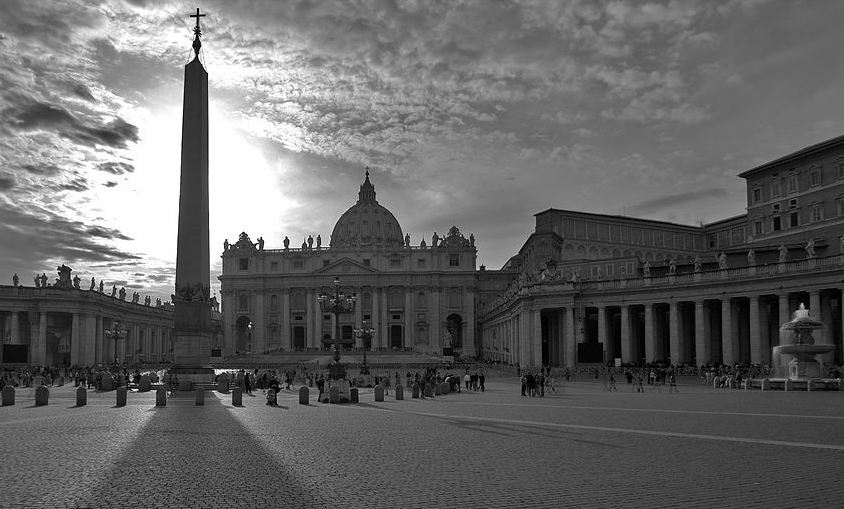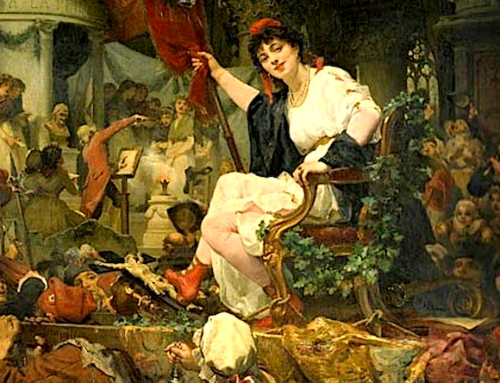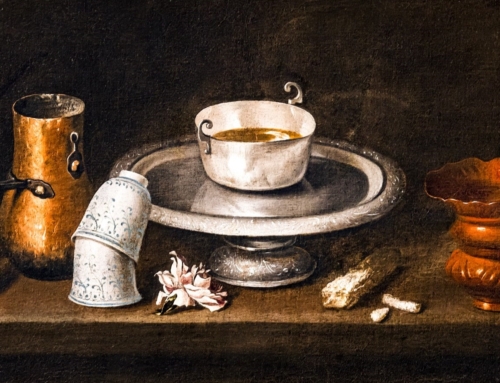Of the writing of many books there is no end, says Ecclesiastes. If Quoheleth had lived during the last year, he might well have said, “Of the making of many myths about Pope Francis there is no end.” As we give thanks to God for the Holy Father on this first anniversary of his papacy, it’s worth taking a moment to look back on some of the myths about Pope Francis that have made the rounds on the Internet this year. While this list could be many more pages long, what follows is my own Top Ten List of Myths about Pope Francis.
Myth #10: That Pope Francis wrote this text: “The church no longer believes in a literal hell where people suffer. This doctrine is incompatible with the infinite love of God.”
This particular myth could be called the Myth that Facebook Made. Different versions of the quote circled around Facebook feeds for a good couple of months, always paired with sunshiney images of smiling Pope Francis oozing sweetness and light from every pore. It’s got everything you could want: it sounds so tolerant and sensitive, it relegates uncomfortable doctrines to the rubbish heap of antiquity, and it sets out the dirty laundry about Hell to be air-dried by the non-violent, non-judgmental love of God (now with Spring Fresh scent!).
The only problem is that everything about it is a lie. The quote itself is from the Diversity Chronicle, a parody website poking fun at political correctness. The article purports to be Pope Francis’ closing speech at the Third Vatican Council, a juicy little bit of “Hey, get it, this is a joke” that got lost in translation through the power of wishful thinking. Add to that the real Pope Francis’ marked penchant for talking about Hell and Satan in unexpected contexts, and the whole thing becomes a little more than far-fetched.
But how did such an obvious hoax gain so much traction? Perhaps because—surprise, surprise—people tend to believe what they want to believe. After a friend pointed out that attributing this quotation to Pope Francis is a bit like North Korea’s state newspaper rejoicing in The Onion naming Kim Jong-Un “Sexiest Man Alive,” another Facebook acquaintance of mine responded blithely, “I choose to believe.” Yes, Virginia, there is a Santa Claus.
Myth #9: That Pope Francis changed Church teaching on homosexuality.
This old chestnut takes its origin from Pope Francis’ impromptu press conference on the flight home from Brazil on July 28, 2013. The headline-making phrase was this: “If someone is gay and is searching for the Lord and has good will, then who am I to judge him?” This little nugget, reduced to a banner-friendly five-word slogan (Who am I to judge?), has been written up in almost every major newspaper in the Western world, and regularly appears on protest signs for Catholic activists pressing for the normalization of homosexuality in the Church.
Here again we might detect the heady aroma of wishful thinking. In 2010, Bergoglio famously made enemies with the government in Argentina over their same-sex marriage policies, declaring what the Huffington Post called a “war of God” against the legalization of same-sex unions. Shortly after Pope Francis’ election, this history was appearing all over the Internet as a stick to beat the Vatican with, that even as the cardinals courageously chose a South American pope (+10 diversity points), they still chose one who held to Church teaching on homosexuality (-100 diversity points).
Nor does the actual context of Pope Francis’ “Who am I to judge” statement suggest a radical change in perspective from his earlier stance: the quotation comes in response to a question about a priest accused of a notorious gay lifestyle and the supposed “gay lobby” in the Vatican. Pope Francis’ tactful and pastoral response was to affirm the humanity and call to holiness of all people, including those who identify as gay, while criticizing the reification of homosexuality as a political and social ideology. The sentences that immediately precede the famous one provide useful context: “I believe that when you are dealing with such a person, you must distinguish between the fact of a person being gay and the fact of someone forming a lobby, because not all lobbies are good. This one is not good.” In other words, love the sinner but hate the sin. That sounds familiar.
Myth #8: That Pope Francis will create women cardinals.
The myth that Pope Francis would create women cardinals made big hay in some ecclesiastical circles, stemming perhaps from a fear that the new pope would seek to implement his desire for a greater involvement of women in the Church by extreme means.
Pope Francis himself addressed this issue in a December 14 interview with La Stampa: “I don’t know where this idea sprang from. Women in the Church must be valued not “clericalised”. Whoever thinks of women as cardinals suffers a bit from clericalism.”
The unsurprising point here, made passionately in the ecclesiastical writings of Cardinal Ratzinger, is that treating every Catholic like an ordained priest—or a cardinal—disrespects the authentic universal priesthood, abandoning the genuine vocation of the laity in favor of a purely clerical vision of the Church. Blurring the lines between the ordained and universal priesthood denigrates the dignity of both.
Myth #7: That Pope Francis hates popular piety.
A major source for this myth was a remark reported by the board of the CLAR (Latin American and Caribbean Confederation of Religious Men and Women) that surfaced in an informal transcript of a private meeting the group had with Pope Francis, in which Pope Francis allegedly denigrated religious groups who do acts of traditional piety like counting rosaries and giving spiritual bouquets as “Pelagian.”
This particular myth, which could be used to paint a negative portrait of Pope Francis as a religious activist who prefers protests and soup kitchens to piety and sacraments, is easy to dispel: just read Evangelii Gaudium §122-126, where he devotes great attention to the evangelizing power of popular piety. I’ve spoken about this issue before.
One would be right to be disturbed about the origin of this myth, though: a single comment excerpted from an informal transcript of a private meeting, taken out of context and promulgated publicly on the Internet as a secret revelation about the Holy Father. In any other context, this would be considered rumor-mongering. Simply as conscientious readers, let alone as Christians, we would do well to be hesitant about believing hearsay about hearsay.
Myth #6: That Pope Francis has publicly advocated the allowance of divorce and remarriage in the Catholic Church.
This myth, too, originates from the in-flight press conference on July 28. Speaking about the broad problem of the pastoral care of marriage, Pope Francis stated that
With reference to the issue of giving communion to persons in a second union (because those who are divorced can receive communion, there is no problem, but when they are in a second union, they can’t…), I believe that we need to look at this within the larger context of the entire pastoral care of marriage. And so it is a problem. But also – a parenthesis – the Orthodox have a different practice. They follow the theology of what they call oikonomia, and they give a second chance, they allow it. But I believe that this problem – and here I close the parenthesis – must be studied within the context of the pastoral care of marriage.
The long quotation is worth giving in full, because it is essential to note that the comparison with the Orthodox practice is part of a side-note giving further elaboration to a complex problem in the Church, not as a specific recommendation that the Church should pursue. The Pope’s argument is that the problem of the pastoral care of marriage is extremely involved and difficult and does not have a single answer, but must be approached with mercy. He insists that it is essential to foster the “anthropological theme” of marriage as the fruitful home of faith in the life of Christians—all in all a theme familiar to readers of John Paul II’s theology of the body.
Myth #5: That Pope Francis doesn’t occupy the papal apartments because they are too luxurious.
A sweet and endearing idea, on the surface: the bus-riding cardinal from Buenos Aires is too in love with Lady Poverty to live in the lavish papal apartments, preferring the humble “hotel” of Santa Marta. But the problem, of course, is the implication that all of his predecessors have been too decadent to be willing to eschew their privileges.
But perhaps more importantly, it’s just not true. In a public interview, he responded to a direct question about his reason for living in Santa Marta, saying:
It wasn’t so much a question of luxury as personality, he said. “I need to live among people,” he said. “If I was living alone, isolated, it wouldn’t be good for me. A professor asked me the same question, ‘why don’t you go and live there (in the Papal apartments)’? And I replied: ‘Listen to me professor, it is for psychiatric reasons,'” he said chuckling.
Certainly, Pope Francis loves the poor, and criticizes clerical decadence with due fervor. But this decision seems to come down to little more than extroversion.
Myth #4: That Pope Francis isn’t pope.
Happily this little myth isn’t as strong in America as it seems to be in Italy, where a fresh round of sensationalist media blustering about the validity of Pope Emeritus Benedict XVI’s resignation caused him to make a rare public statement dispelling the rumors. In short, papal resignation is provided for in a once-obscure canon in the Code of Canon Law, a decision that once freely made by the pontiff needs no approval or secondary ratification by any other source. That having been done, the papal conclave’s gathering and election of Pope Francis was simply the ordinary procedure followed during a period of sede vacante. The charges to the contrary, being merely conspiratorial, can only be termed, in Pope-Emeritus Benedict’s word, “absurd.”
Myth #3: That Pope Francis is a Marxist.
The release of Evangelii Gaudium brought a fresh wave of furor about Pope Francis, but this time from a new source: economists and political theorists who identified certain passages as displaying Marxist sympathies, notably §202, where the Pope says: “As long as the problems of the poor are not radically resolved by rejecting the absolute autonomy of markets and financial speculation and by attacking the structural causes of inequality, no solution will be found for the world’s problems or, for that matter, to any problems.”
Again, Pope Francis himself addressed this concern in the December 14 La Stampa interview. In response to a question about whether he gets upset that people call him a Marxist, he said: “The Marxist ideology is wrong. But I have met many Marxists in my life who are good people, so I don’t feel offended.”
Beyond his light-hearted response is a deeper reality about the principles of Catholic social thought. Catholic social thought has consistently maintained its opposition to two basic extremes: Marxism and unfettered capitalism. Pope John Paul II’s Centesimus Annus eloquently encapsulates this fundamental stance, then urges the faithful to a renewal of society by a renewal of culture, recognizing that the issues of justice in the field of economics will not be resolvable until man is considered as more than an economic object. The economic passages in Evangelii Gaudium, while not developed into a complete social doctrine, merely continue a line of thinking familiar to the Church for many decades. While one might be dissatisfied with the brevity of his remarks in Evangelii Gaudium, one could hardly call them innovative.
Myth #2: That Pope Francis hates the Extraordinary Form of the Mass.
Within hours of the election of Pope Francis, one Catholic blog (which describes itself as “the most-read international traditional Catholic blog on the Internet”) ignited a firestorm by posting an essay asserting that Pope Francis is “a sworn enemy of the Traditional Mass,” and that “he has only allowed imitations of it in the hands of declared enemies of the ancient liturgy.” In the days that followed, various commentators offered their impressions on the question of Pope Francis’ inner thoughts concerning the Extraordinary Form of the Roman Rite, often seeming to base their impressions on what they could garner from Google searches. The question became even more heated when news broke in July 2013 that the Vatican had restricted the use of the Extraordinary Form of the Mass within a particular religious congregation which was experiencing internal tensions concerning a variety of issues.
Yet when we turn to the actual statements of Pope Francis, we find that here too he exhibits greater nuance than the histrionic headlines might suggest. In his August 2013 interview with Fr. Antonio Spadaro, Pope Francis explained his position on the older form of the liturgy:
Then there are particular issues, like the liturgy according to the Vetus Ordo. I think the decision of Pope Benedict [his decision of 7 July 2007, to allow a wider use of the Tridentine Mass] was prudent and motivated by the desire to help people who have this sensitivity. What is worrying, though, is the risk of the ideologisation of the Vetus Ordo, its exploitation.
Pope Francis makes three key points in this passage: first, that there is a group of people in the Church attracted to the Extraordinary Form whose desires pose a legitimate pastoral need; second, that permitting a wider use of the Extraordinary Form is a “prudent” response to that need; and third, that this form of the liturgy must not be suborned to ideological ends.
This trilogy of points exactly matches what Pope Benedict himself had to say on the question. In a letter to bishops explaining Summorum Pontificum, Pope Benedict wrote: “It is true that there have been exaggerations and at times social aspects unduly linked to the attitude of the faithful attached to the ancient Latin liturgical tradition. Your charity and pastoral prudence will be an incentive and guide for improving these.” We see here the same three points: the presence of those legitimately interested in the Extraordinary Form, the need for charity and prudence in satisfying this need, and the concern about ideology subsuming liturgy.
Pope Francis is not Pope Benedict, so we can reasonably expect differences in emphases on questions of pastoral prudence like this one; what is clear, however, is that Pope Francis’ fundamental starting points on the question of the Extraordinary Form and its pastoral place in the Church align closely with his predecessor’s.
Myth #1: That the hermeneutic of continuity no longer applies now that Pope Francis is pope.
I suspect that this myth, while only implicit in discourse about Pope Francis, is at the root of the previous nine myths, and all the others we haven’t been able to examine. Speaking of the reception of Vatican II, Pope Benedict famously taught that theologians needed to reflect on the Council as a theological event in continuity with the rest of magisterial tradition, rather than as a dramatic rupture proposing a totally new vision of the Church, God, and the world.
But the hermeneutic of continuity is a useful principle to apply to papal teachings as well, be they from John Paul II, Benedict XVI, Francis, or any other pope. Anyone who speaks and writes as much as a modern pope will, on occasion, say things that could be taken out of context and cast as a totally new theological creation. But a prudent reader—or listener—would be better advised to approach papal pronouncements sympathetically, positioning them with respect to the pope’s wider teaching, and to the larger tradition of the Church.
Rather than succumbing to sensationalism or skepticism, those of us who attend to what Pope Francis says and does may find that a patient response that assumes Pope Francis is actually what he purports to be—a faithful Catholic and the custodian of the unchanging deposit of faith—will help even the most perplexed reader out of the mazes of papal myth.
✠
Image: Michal Osmenda, St Peters Square







